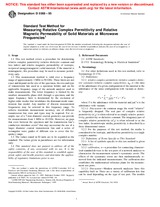We need your consent to use the individual data so that you can see information about your interests, among other things. Click "OK" to give your consent.
ASTM D5568-95
Standard Test Method for Measuring Relative Complex Permittivity and Relative Magnetic Permeability of Solid Materials at Microwave Frequencies
STANDARD published on 10.3.2001
The information about the standard:
Designation standards: ASTM D5568-95
Note: WITHDRAWN
Publication date standards: 10.3.2001
SKU: NS-31701
The number of pages: 15
Approximate weight : 45 g (0.10 lbs)
Country: American technical standard
Category: Technical standards ASTM
Annotation of standard text ASTM D5568-95 :
Keywords:
coaxial line, dielectric constant, magnetic permeability, measurement, microwave, millimetre-wave, permittivity, radio frequency, rectangular wave guide, scattering parameter, transmission/reflection, ICS Number Code 17.220.01 (Electricity. Magnetism. General aspects)
Additional information
| Significance and Use | ||
|
Design calculations for Radio Frequency (RF), microwave and millimeter-wave components require the knowledge of values of complex permittivity and permeability at operating frequencies. This test method is useful for evaluating batch type or continuous production of material for use in electromagnetic applications. It may be used to determine complex permittivity only or both complex permittivity and permeability simultaneously. |
||
| 1. Scope | ||
|
1.1 This test method covers a procedure for determining relative complex permittivity (relative dielectric constant and loss index) and relative magnetic permeability of isotropic, reciprocal (nongyromagnetic) solid materials. If the material is nonmagnetic, this procedure may be used to measure permittivity only. 1.2 This measurement method is valid over a frequency range of approximately 1 MHz to 50 GHz. These limits are not exact and depend on the size of the specimen, the size and type of transmission line used as a specimen holder, and on the applicable frequency range of the network analyzer used to make measurements. The lower frequency is limited by the smallest measurable phase shift through a specimen, and the upper frequency limit is determined by the excitation of higher-order modes that invalidates the dominant-mode transmission line model. Any number of discrete measurement frequencies may be selected in this frequency range. To achieve maximum measurement accuracy, use of different transmission line sizes and types may be required. For example, use of a 7-mm diameter coaxial geometry can provide for measurements from 1 MHz to 18 GHz. However, air gaps that exist between the specimen and the transmission line's conductors introduce errors that may necessitate the use of a larger diameter coaxial transmission line and a series of rectangular wave guides of different size to cover this frequency range. 1.3 The values stated in SI units are to be regarded as the standard. The values given in parentheses are for information only. 1.4 This standard does not purport to address all of the safety concerns, if any, associated with its use. It is the responsibility of the user of this standard to establish appropriate safety and health practices and determine the applicability of regulatory limitations prior to use. |
||
| 2. Referenced Documents | ||
|
We recommend:
Technical standards updating
Do you want to make sure you use only the valid technical standards?
We can offer you a solution which will provide you a monthly overview concerning the updating of standards which you use.
Would you like to know more? Look at this page.




 Cookies
Cookies
